This post is going to give you some ideas and inspiration for how you can get PR coverage, build relationships, get reviewed by blogs, and earn more traffic by promoting your business using Postaga.
Getting your business noticed can be a big challenge.
You may have spent a lot of time building the perfect product, service, or app, but may not be getting many new customers because people do not know about you.
Postaga can help.
Postaga can help you promote your product/service/app/business to get you the coverage and traffic you are looking for.
For this, all you need is a website for your business, and an account at Postaga.
If you are reading this but not familiar with Postaga, Postaga is a tool that helps you create outreach campaigns to build relationships, get shares, earn backlinks, and get traffic to your website.
The inspiration for this blog post comes from a few questions we have received recently:
“If I want to promote my app, how can I use Postaga?”
So, I wanted to put together this blog post, and a video below, on how to promote your content.
(Also accompanying this post will be a video, coming soon!)
Postaga Campaigns You Should Run to Promote a Business
For any business / app / product / service, there are a few different campaigns I would run, no matter the business concept.
Very briefly, those campaign types are:
- Reviews outreach
- Tools outreach
- Podcast outreach
- Offer expertise outreach
- Reverse mention outreach
- Custom search outreach
- Custom URLs campaign
First, I will explain the campaigns and how I use them.
Then I will get to how to build a campaign in Postaga.
Reviews Campaign
In this campaign, we are going to find blogs that have reviewed your competitors as well as related or complementary products/services/apps and try to get your product reviewed.
You have seen reviews of products on blogs before.
That’s nothing new.
But, how can you get blogs to notice you?
With this type of a campaign, you will search for a specific product to find other blogs that have reviewed it. Then, you can reach out to them, pitching them to review your product as well.
Since your product is relevant to the product that the website already reviewed, your product should be a good fit for this blog’s audience
Related: How to run a reviews campaign in Postaga
Tools Campaign
In this campaign, we are going to find other blogs’ tools pages and try to get our blog post added to them.
Tools pages are other peoples’ lengthy blog posts or webpages that share links to other helpful products/services/apps/etc. on a given topic.
Here is an example of a good tools page:

This post shares tons of links to other websites on the topic.
Wouldn’t it be great if they updated that article, adding a link to your amazing product/app/business?
Heck yes it would.
With a tools campaign in Postaga, we search for relevant tools pages on your given business area, and then we suggest they update their article, adding a link to your website.
Related: How to run a tools outreach campaign in Postaga
Podcast Outreach
Being a guest on podcasts can be a great way to promote your business or brand and get you in front of a new audience.
With Podcast Outreach, you can find podcasts on your topic, get their contact details, and pitch them your guest spot.
With pitching podcasts, I recommend having a good pitch to demonstrate:
- You know who they are and their target audience
- You have some value to provide their audience
- You can also help out the podcast by promoting them to your audience (like if you have any email subscribers)
I’ve been doing this type of outreach for awhile now and have been featured on podcasts recently including The Agency Profit Podcast, LMSCast, Content Champion, and more.
Related: How to promote yourself to be a podcast guest
Offer Expertise Campaign
In an offer expertise campaign, you search for websites that feature “expert roundups” on a given topic, and then reach out to them to share your opinion, and hopefully get featured.
To build your company’s profile, it’s often helpful to get quoted in other blogs as being an expert on a given topic.
With Postaga, you can easily find and reach out to these opportunities.
It’s called Offer Expertise Outreach.
With Offer Expertise Outreach, you can find other websites that have experts weigh in on a given topic or subject. For example, “24 Experts on How to Become a Great Public Speaker.”
Then, you can introduce yourself to them and pitch your expertise.
Related: How to run an expertise campaign in Postaga
The Reverse Mention Campaign
This is a campaign type that I have been exploring recently.
It uses Postaga in a way we had not originally thought of, but it can be very effective.
Sometimes when you find a webpage or article, you’ll see that it has a ton of outbound links. Good examples of these are tools pages or pages directory listing pages (the kind that list different types of websites or businesses).
Some of these websites or posts might be good for you to connect your post with as well.
So, once you find a website like that, you can take note of the website URL, then run a mention campaign on that URL.
That will scrape all the outbound links on those webpages.
From there, you can build a tailored outreach campaign to those websites with your unique ask.
I have used a reverse mention campaign to reach out to different podcasts that I found on podcast directory pages, as well as websites for guest posts.
Related: How to run a mention campaign in Postaga
Custom Search Campaign
With a custom search campaign, you are going to find relevant websites to reach out to, and then email them. This is particularly effective for doing cold outreach.
A custom search campaign is an open-ended campaign type that lets you enter in a keyword into Postaga, find websites relevant to that keyword, and build a campaign to connect with those websites.
This campaign type can be especially useful for cold outreach.
For example, if you make a b2b product and your target users are hair salons, you could search for “Hair Salons in [city name].” Then, you could build a cold outreach campaign targeting them, pitching your service.
After that, you could build another identical campaign targeting a different city.
And with Postaga you will know: 1) the city of the people you are reaching out to; 2) their names; 3) their business names; and sometimes 4) their social media accounts. This data can be integrated into your outreach emails, helping you to easily personalize them much more.
There are limitless possibilities here.
I have personally used this campaign with great success to share Postaga with blogs and businesses.
Related: How to run a custom search campaign in Postaga
Custom URLs Campaign
With a custom URLs campaign, you are going to enter in relevant URLs you have collected to Postaga, and build a campaign to connect with people at these websites.
A custom URLs campaign lets you paste relevant URLs into Postaga, find contact information for people at these websites, and build an email campaign for them.
This will require you to do some research outside of Postaga though. First you will need to find the relevant websites you want to connect with.
Then you’ll import that into Postaga with either a Custom URL campaign or upload the data from a CSV into a Skyscraper campaign.
How to Do a Blog Promotion Outreach Campaign in Postaga
Next, let’s go through the process of how we promote a blog post using Postaga.
First, we will choose a campaign type.

Then, you are going to enter your website URL and click the Analyze button.
Your Post
In this section, Postaga shows your analyzed post, with any additional custom post merge fields that you’ve added.
Postaga will pre-fill any information it finds in your post. You can also click on any given text box field and edit the value.

These fields are important for your campaign because we can use them later as merge fields in our outreach emails.
The data in these fields can be pulled into your emails wherever you have the appropriate merge field. As an example, if your post title is set to “Great Blog Post” and you have a sentence in your email “Check out this post: {{post_title}},” Postaga will swap in “Great Blog Post” where the {{post_title}} merge tag exists in the email, making the final output, “Check out this post: Great Blog Post.”
These post related fields (and their corresponding merge variables) include:
- Post Title (post_title) = your blog post title
- Post Site (post_site) = your website name
- Post Search Keyword (post_keyword) = your target keyword
- Post Category (post_category) = your blog post’s category
- Author Name (post_author) = Author of your blog post
Below these, we also have post related fields for any custom merge fields that we may have created. You can create your own post merge fields in Settings.
Then, Postaga will find all the websites you linked to in your post, and a contact for each website, if possible.
Links
Postaga will then give you a list of the links to the websites you selected, along with a target contact for each website.

Here, you have options for Basic Configuration and Advanced Configuration.
First, let’s review Basic Configuration.
Postaga will automatically try and find the best fit contact for each website.
As an example, for a blog post, that will usually mean the author of that post. Otherwise, Postaga will look for its determination of the next best-fit contact.
You can review each website and contact by clicking the "1 link" button, on a specific contact, which will then show you the target contact for that website.
The First Name, Last Name, and Site/Company fields are all editable.

If you would like to search for a different contact, Postaga can help there too.
If you see a + symbol next to the website, you can click it, and you will get results of other contacts at the website that you can choose from. Then, if you click the Use Contact button, you can select that contact.
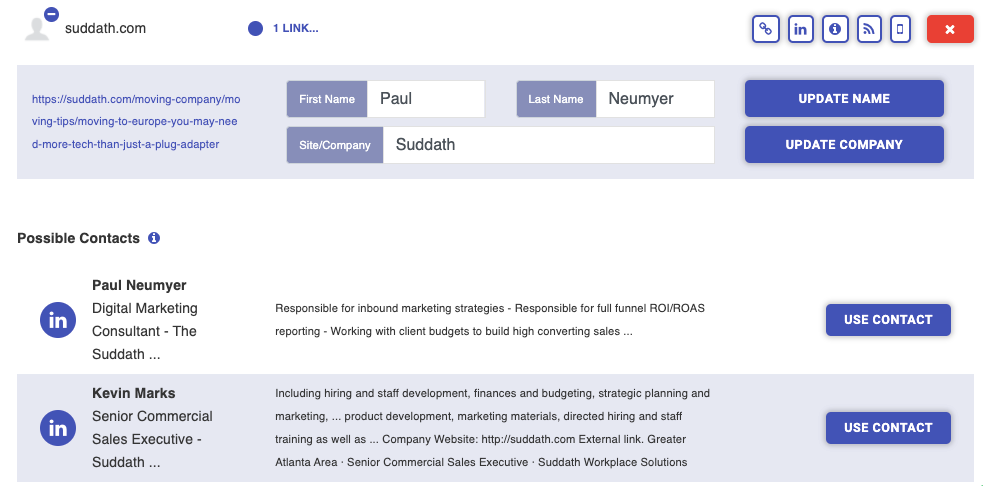
Next, there’s Advanced Configuration.
In Advanced Configuration, you are presented with every merge field for the website, including custom merge fields. You can fill these boxes if you want, or do that later.
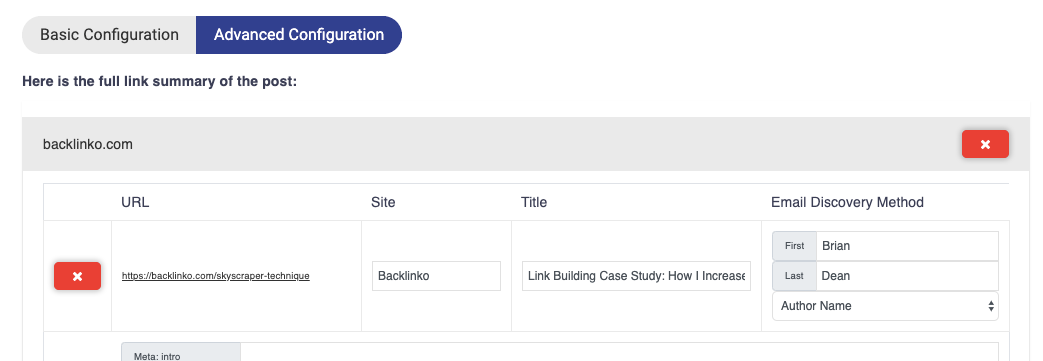
Once you are satisfied, click the Get Contacts button.
Now, you will see the contacts.
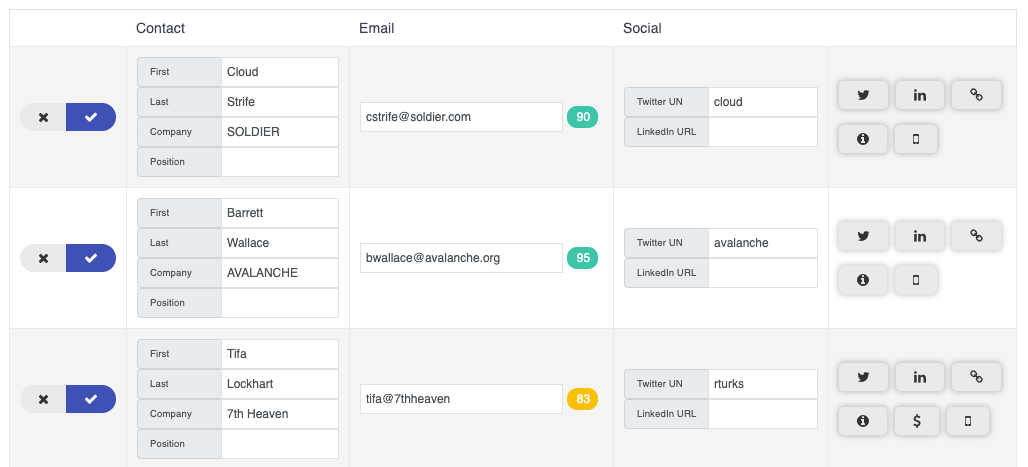
On the left side of the screen, next to each contact, is a checkbox. With the box selected, that individual contact will be added to your email sequence.
Though you will see email addresses for each contact, some information may not be available, such as name, company, position, social media handles, or any custom contact merge fields.
If you would like, you can supplement that information and add that to contacts by filling it in the appropriate text boxes.
Also, you can edit existing contact information text boxes. As an example, if the Company Name returned is Acme Company, Inc., but you want to just refer to the company in merge tags as Acme, you can edit that field as needed.
Next to each email address found is a numerical contact score. This indicated how confident we are that the email address is accurate. If the contact score shows as red, you can click the score to bring up a validator and try to validate the email through Mailgun.
To the right of each contact are icons for Twitter, Linkedin, the original link, and a few other key pages at that contact’s website.
If a Twitter handle is provided , clicking the Twitter icon will load up a default tweet, presuming you are already logged into Twitter. Otherwise, it will perform a Google search for the Twitter handle of the contact.
If a LinkedIn url is found clicking the LinkedIn icon will load the contact’s LinkedIn profile. Connecting with a contact on LinkedIn before emailing can be a great way to increase response rates. If a LinkedIn url is not provided, clicking the icon will perform a Google search for the contact’s LinkedIn profile.
Clicking the link icon will take you to the original link.
You can also toggle between Basic Configuration and Advanced Configuration to make edits to all available merge fields.
Once you are satisfied with the outreach contacts, you can move onto editing the email sequence.
Email Sequence
Next, you will choose an email sequence for your contacts.
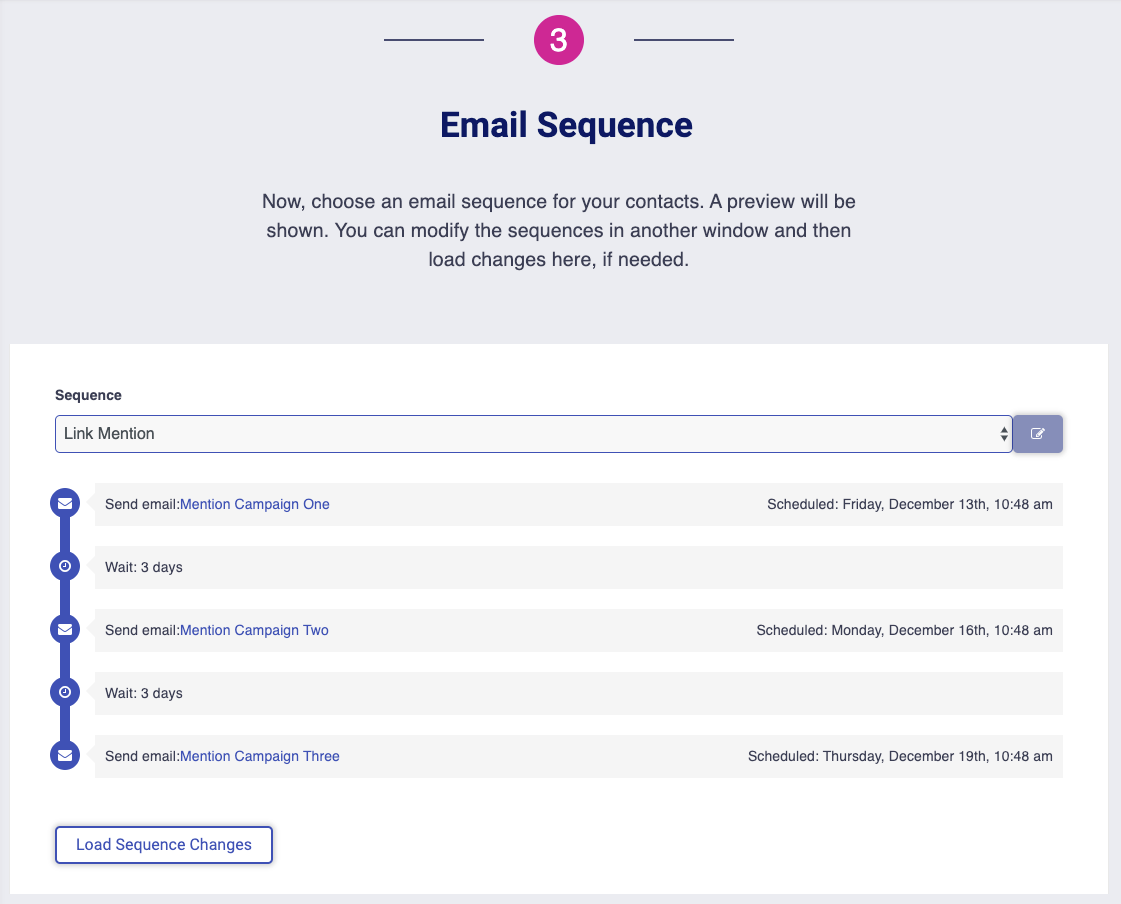
Email sequences available to you will include any sequences that you created and assigned to this particular campaign type, sequences assigned to “any” campaign, as well as template sequences created by Postaga.
Once you select a sequence from the drop-down menu, you will see the sequence laid out on the screen.
If you are not happy with the sequence, you can always modify the sequence by going to Sequences in another window by clicking the edit button to the right of the selected sequence. Then, you can edit the sequence, save it, and then reload the sequence section in you campaign by clicking the Load Sequence Changes box below the sequence.
Related Help Doc: Sequences
Email Preview
Next, you will see an email preview section with the email templates of the sequence you selected.
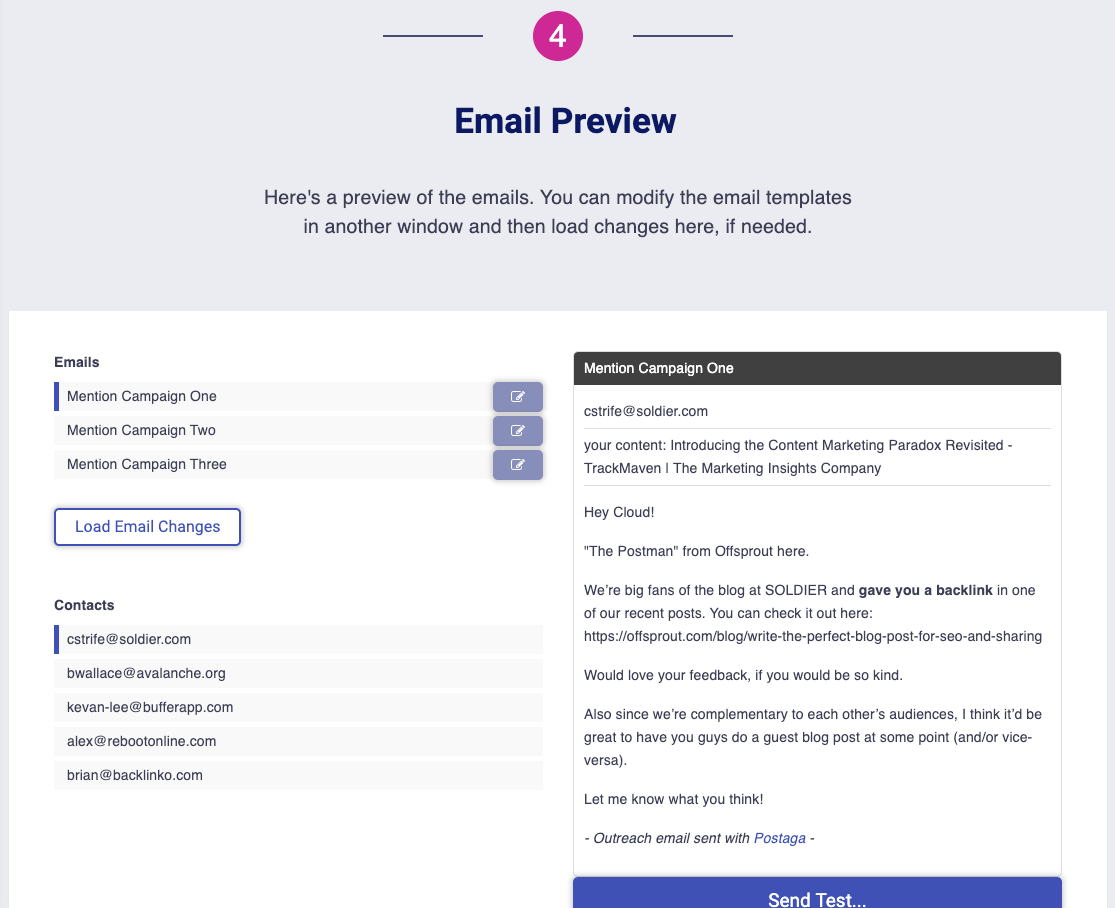
On the left side of the page are the list of emails as well as contacts who will receive each email. If you click on a specific contact as well as a specific email, you will see that email as it will send to that specific contact in the preview pane on the right side of the page.
If there are merge fields used in your email template, they will fill with the supplied information in the preview pane.
However, you may also see merge tags in red. If you see red merge tags, it means that Postaga does not have data for these merge fields. You can always go back and provide that information to see how the revised email will look with the new information.
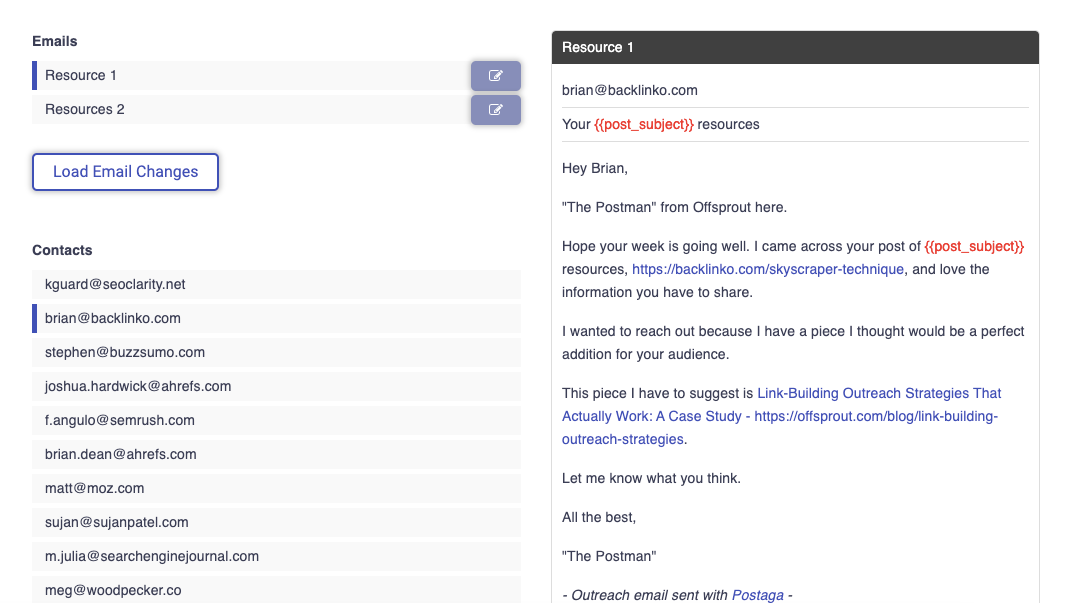
Alternatively, you can edit the email by clicking the edit icon to the right of the email, then clicking the Load Email Changes button to see how the revised email will look. Any changes here will affect the template, and therefore, every message using that email template.
It should be noted that red merge tags do not show up in outreach emails. If there are any red merge tags when you send out your campaign, they will disappear from the outreach email and your contact will not see anything where the merge tags would have been.
You can overwrite individual emails in this section as well. To do so, just hover over the email, and you will see the screen darken and an edit icon appear. This will let you edit an individual email in the sequence, related to the contact that is highlighted in the left side of the screen.
Once you click the edit button, a modal window will pop up, allowing you to edit that unique email.

One cool feature to note here is that you can insert unique snippets to your personalized email. For example, let's say you want to mention something specific on your contact's website that you appreciated. Postaga's AI pulls mention-worthy snippets from your contact's post or URL, so you can paste it in your message.
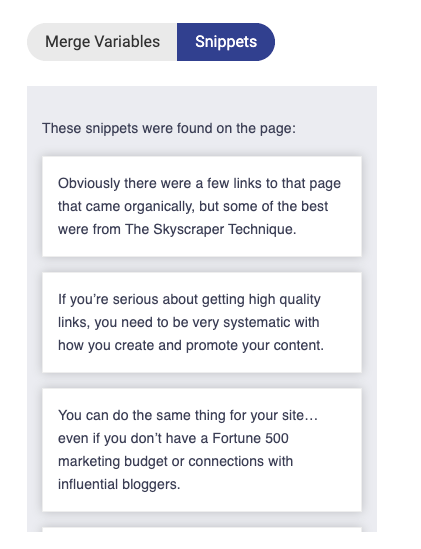
Once you are happy with the edits you have made, click the Save Email Overwrite to save the individual email, or Close to undo any changes.
To send a test email, click the Test Email button below the email in the preview pane. Then, enter the email address for the test and click send.
Rules and Scheduling
Next, you will set the rules and schedule for your email.

The Schedule button has a checkbox option. If you select it, you will be able to schedule your sequence to run at a given day and time. If not selected, the sequence will run as soon as you click the Launch button at the end of this campaign screen.
If you select a schedule, click the text box under Start Date to select a start date and time.
Below the schedule button is a Testing Mode button. If selected, the email sequence will send all the emails to your test email address, but not your actual target recipients. This is generally used for situations where you want to confirm what emails people will receive, though you can also do this in the Email Preview section.
There is also a Send on Weekends option that you can select. If it is not selected, your email sequences will only send on Monday through Friday; any emails that would have been scheduled to send on a weekend day will send on the first following weekday (e.g. if scheduled for a Saturday or Sunday but “Send on Weekends” is not selected, it will send on Monday).
There is also a rule for Stop on Reply. If selected, the sequence will stop for a specific recipient if they reply to any of your emails. For example, if I have an email sequence with 5 emails, and a recipient responds to my 2nd email in the sequence, the sequence will stop for them and they will not receive emails 3, 4, or 5.
Track Opens lets you know if your email opens are being tracked. If you have configured your Postaga account fully, this should say “Opens are automatically tracked.”
Schedule and Launch
With your campaign created, it’s time to launch your campaign.
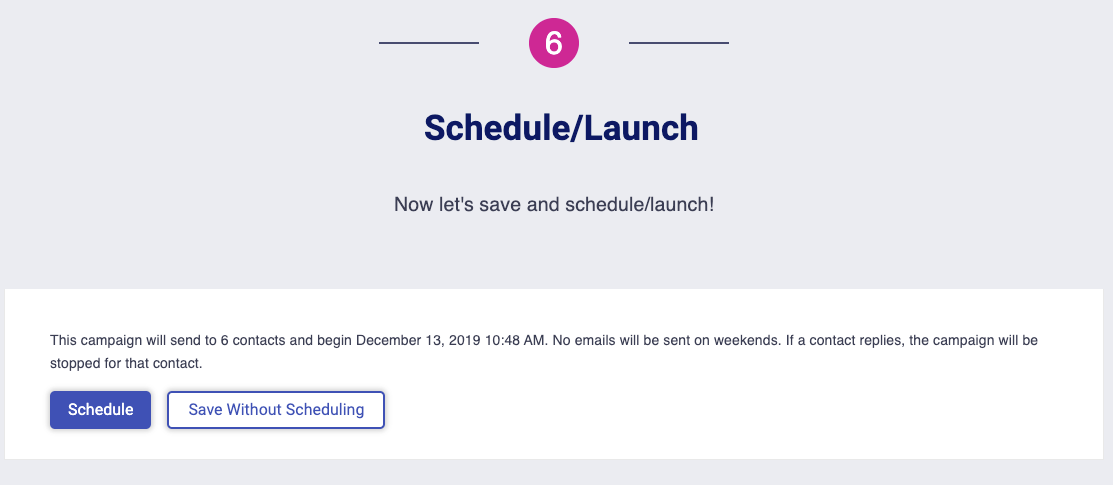
Free 14-Day Trial
Start building relationships now with your fully-featured 14-day trial!
How We Compare
Terms | Done-For-You Terms | Privacy | Write For Us | Press
© 2024 Postaga. All Rights Reserved. Made with 
